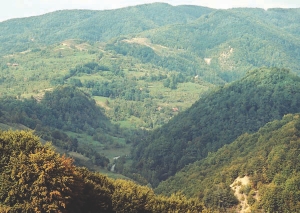VANCOUVER–After four years and more than 71,000 metres of drilling, Carpathian Gold (CPN-T) has defined a gold-copper resource in Romania that could support a combined open-pit and underground mining operation producing almost 200,000 oz. gold and 50 million lbs. copper annually for 19 years.
The Rovina Valley project is in west-central Romania, in an area known as the Golden Quadrilateral. Over the last 2,000 years the Golden Quadrilateral has produced more than 55 million oz. gold, making it one of Europe’s most prolific gold districts. The yellow metal is hosted in epithermal veins and porphyries.
Since winning the 94-sq.-km Rovina Valley project in a public tender process in late 2005, Carpathian has defined three deposits at the site. First the company delineated the Colnic gold-copper porphyry, and then it outlined the Rovina porphyry deposit 2.5 km to the north. In late 2008, Carpathian discovered the blind Ciresata gold-copper porphyry to the south of Colnic, beneath 75 to 150 metres of altered but barren cover. The three porphyries occur within 7.5 km along a north-northeast trend.
Now a preliminary economic assessment has outlined an initial mine plan for the multi-deposit project. The plan calls for open-pit mining of the Colnic and Rovina deposits and bulk-underground mining of the Ciresata deposit, with rock from all three operations feeding a central mill. The mill would process 40,000 tonnes of ore daily with half of the mill feed coming from the underground mine at Ciresata.
Using only flotation, the processing plant would recover 68% of the ore’s contained gold and 91% of its copper to produce a gold-rich copper concentrate. By focusing on each deposit’s higher-grade core in the early years of operation, the Rovina Valley mine should be able to produce 238,000 oz. gold an 53.5 million lbs. copper annually during its first five years. Over the 19-year mine life, annual production would average 196,000 oz. gold and 49.4 million lbs. copper, for total production of 3.72 million oz. gold and 938 million lbs. copper.
It will not be cheap to build the multi-deposit mine. The study estimated initial capital expenditures at US$509.4 million. Part of that investment would go towards a 6- km long inclined conveyor tunnel to bring ore from the underground mine at Ciresata to the centralized process plant located between the Rovina and Colnic deposits.
The open pit at Rovina would require a strip ratio of 2.4 to 1. The Colnic pit is slightly better suited to open-pit mining, requiring a strip ratio of only 1.6 to 1. As for the underground operation at Ciresata, sublevel panel retreat mining in the upper levels would allow access to the deposit’s higher-grade zones at first; the deeper, lower-grade portion of the deposit would then be mined using block caving.
Once the mine is built, Carpathian can expect to produce an ounce of gold for US$379, net of copper credits.
Using metal prices of US$900 per oz. gold and US$2.25 per lb. copper and an 8% discount rate, the Rovina Valley project generates a net present value of US$316 million and a 15.7% internal rate of return. Mine cash flow would allow capital payback in 4.9 years.
Carpathian’s president and CEO Dino Titaro says he is pleased with the results of the preliminary assessment, especially in light of the resource expansion potential that still remains at Rovin ina Valley. Many of the drill holes at Ciresata ended in mineralization, indicating the potential to grow that gold-rich resource at depth, and it also remains open laterally. In addition, Carpathian has identified other nearby porphyry targets that the company plans to drill test soon.
Currently, Rovina Valley is home to a measured and indicated resource totaling 193.1 million tonnes grading 0.49 gram gold per tonne and 0.18% copper. Inferred resources add 177.7 million tonnes averaging 0.68 gram gold and 0.17% copper. The resource tonnage significantly exceeds the tonnage in the mine plan, as mineable tonnages were estimated using base-case economic cutoff grades. Carpathian will review these cutoffs as the project proceeds into the feasibility stage. The company will also try to improve gold recoveries, which in a flotation-only process are hindered by the presence of pyrite.
The Rovina Valley project is in an area with a long history of mining. In addition, a state-owned underground gold mine just 7 km to the west operated until two years ago. Carpathian says its local stakeholder engagement program has won support from most people living in the area.
Carpathian’s other major focus is the Riacho Dos Maschodos gold project in Brazil. A preliminary economic assessment there contemplated a 6,000-tonne-per-day open pit operation producing 102,050 oz. gold annually for 7 years.
On news of the Rovina Valley assessment, Carpathian’s share price lost half a penny to close at 41¢. The company has a 52-week trading range of 17.5¢-47.5¢ and 281 million shares outstanding.


Be the first to comment on "Carpathian proves positive economics at Rovina"